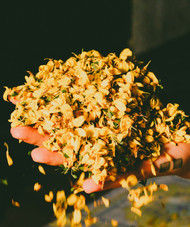How Grasse’s Blooms Become the World’s Finest Perfumes
Posted by MAIR on Jul 22nd 2025
From Flower to Flacon and How Grasse’s Blooms Become the World’s Finest Perfumes
The hills of Grasse are rich with history and even richer with scent. But the magic of this perfume capital isn’t just in the flowers that bloom there. It’s in the craftsmanship that transforms petals into perfume, distilling fleeting florals into wearable memory.
Today, we complete our Grasse series by exploring the journey from bloom to bottle. You’ll understand what makes this region so revered, and why it continues to set the gold standard in fragrance creation.
1. Harvesting at the Right Time
It starts in the fields. Whether it’s May rose, jasmine, or tuberose, harvesting in Grasse is still largely done by hand to protect the integrity of each bloom. Timing is everything. Rose de Mai, for instance, is picked early in the morning when its scent is at its peak. The window is short, just three to four weeks each May, and every day counts.
Each flower has its season, and most are harvested in the cool hours of the day to preserve the essential oils before the sun depletes their potency.
2. From Petals to Perfume Oil
Once harvested, the flowers are quickly brought to nearby facilities for processing. Traditionally, Grasse used enfleurage, a slow and laborious method of capturing scent in fat. While that technique is mostly retired today, the region still values gentle methods like steam distillation and solvent extraction, which preserve the nuance of delicate blooms.
Jasmine and tuberose, for example, require solvent extraction to yield what is called an absolute, a highly concentrated, aromatic oil used in high-end perfumery. These oils are precious. It can take 7,000 jasmine flowers to produce just one gram of absolute.
3. The Role of the Néz (Perfumer)
Once the raw materials are ready, the néz or “nose” takes over. A perfumer’s job is to compose a fragrance with balance, emotion, and wearability. They select notes, layer ingredients, and consider how the scent evolves from the initial spritz to the drydown.
Many perfumers trained in or traveled to Grasse for its access to rare materials and generations of knowledge. Some still rely on trusted producers from the region to this day.
4. Formulation and Maturation
After the formula is developed, the ingredients are mixed with alcohol (or sometimes oil) and left to macerate. This period allows the blend to settle and intensify. Like wine, fragrance needs time to open up.
Once macerated, the mixture is filtered and bottled. Every part of this process, from sourcing to blending, impacts the final scent and how it wears on your skin.
5. Why This Still Matters Today
In an industry increasingly driven by speed and scale, Grasse represents the opposite. It reminds us that beauty takes time. That luxury is earned. And that a single bottle can carry the weight of generations.
When you wear a perfume crafted from Grasse’s fields, you’re not just wearing scent you’re wearing history, craft, and care.
This Blog is Part of a Series
If you enjoyed this story, make sure to read the earlier entries in our Grasse series:

